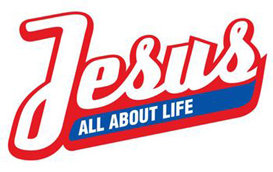
This blog post contains recommendations for the Jesus All About Life campaign. Majority of these may appear as trivial and extremely obvious, but I believe they are the fundamental basics that individuals/groups/corporations have to get right if they wish to utilise the web technologies of today and more importantly, maintain an image of control and competence.
These recommendations, whilst focused on this specific campaign, are still highly relevant for everyone. They are also easily implementable :)
GENERAL RECOMMENDATIONS
- Think online.
Not only is the Internet a cheaper medium to advertise on compared to traditional mediums (television, broadcast, print, radio), it also has far greater reach than any of them. It is a well-known fact that the Internet transcends local and even national communities, countries, cultures, time zones. One goal of Jesus All About Life Campaign is to increase the public’s awareness of Jesus. The internet is the perfect medium to assist in achieving this goal.
Another reason for focusing on web technologies (as opposed to traditional medium) is that there has been a mass movement from the traditional "old" media to the "new" media by the younger demographic of global society. A proportion of Gen X and the majority of Gen Y are less inclined to read physical print. Interesting fact: according to a study conducted by the Pew Research Centre, a tipping point occurred in early 2009 in America, where more individuals sourced their news online for free, than paid for it by buying newspapers and magazines. Putting one obvious reason aside (online news is free, for now at least), I think it is fairly obvious where the storage, retrieval and publishing of information is headed: online.
I recommend the campaign continue using the web technologies used in the past campaign and offer Foursquare, the geo-location service (not the ball game), as another platform to be utilised in future campaigns. I do not see much relevance in exploiting the mayor and badge models for a campaign of this nature. While these bread-and-butter features of Foursquare are proving invaluable for many businesses today, I offer that which is on the horizon - the Foursquare Promotions Functionality. This new feature identifies nearby specials based on your location.
What attracts me to this feature is that you are easily able to instantly increase your potential audience. No longer are you bound to static individuals who view the event information behind a computer screen. You are now interacting with the mobile users. Through a simple mobile data connection and being in the neighbourhood, individuals who may not have known about the event or campaign, can be accessed.
This functionality is suitable for Jesus All About Life events, such as the free barbecues.
- Reconsider television as a campaign medium.
From my research of the Jesus All About Life television advertisement, there has been mixed feedback regarding its reach and exposure. Some individuals had seen the advertisement on Channel 7, whilst others (including myself) had not. Considering this mixed response, I question the effectiveness of television as a medium for this campaign. Furthermore, considering the high costs associated with brainstorming, producing and broadcasting the advertisement, I question whether television should be part of the strategy in the next campaign.
What I would like to see is the data of viewer behaviour when the advertisements were aired. Did viewers instantly flick away (a potential sign of television not being so effective) or did they watch the whole advertisement. Another trend I would look for in this data would be viewer behaviour towards subsequent showings of the advertisement after they viewed the first screening. Yes, this data can be mined for many other trends. I am only highlighting two , which I find particularly interesting.
- Reassess the print strategy. At the start of, and even during, the campaign, I observed several news articles informing about the theft or vandalising of banners and posters associated with this campaign. The printing costs of this media is extremely high, and instantly lost when this occurs. I recommend that the funds towards banners, posters and similar articles be minimised and/or channelled elsewhere within print media (such as providing more teaching resources to the involved churches) or elsewhere in other communication channels.
The following section details recommendations per channel/touch-point utilised in this campaign.
WEBSITE
- Become W3C Compliant. The World Wide Web Consortium (W3C) has a free, online mark-up validation service. Becoming W3C compliant is important as invalid mark-up can affect the accessibility of the site from users using older browsers, or mobile devices. Invalid mark-up has an even greater impact on disabled users who completely rely on screen readers. Whilst some screen readers and other assistive technologies have been developed to be more 'tolerant' towards invalid markup, its recommended to follow best practice and develop with standards and accessibility in mind. The W3c has published a Web Content Accessibility Guideline (WCAG) which explains how to make online content more accessible.
- Practice Progressive Enhancement.
Progressive enhancement is a web design and development strategy that adopts a layered approach towards content and functionality. It assumes a fundamental belief that content will always be accessible to the user. The progressive enhancement comes in the user experience, which can be enriched through other means such as JavaScript.
I believe progressive enhancement can be implemented on the Google Map widget, which is found on the homepage. When JavaScript is disabled, users are unable to access the functionality or data associated with this widget. I recommend that the data accessed by the widget be output to another page, to improve accessibility.
YOUTUBE CHANNEL
- One brand. Multiple Platforms.
Campaign branding should be consistent and seamless irrespective of the platforms used in the campaign (website, Facebook, Twitter or YouTube). This not only reinforces the image associated with the campaign, it improves user experience when bouncing between platforms.I recommend that the YouTube Channel be customised, to be more in-line with the website. I have listed the steps to achieve this below:
i. Login > Click 'Account' Click 'Edit Channel' (see screenshot) ii. Click 'Channel Design' (see screenshot) iii. Customise your Channel (see screenshot) (An an example, I lifted the website background and temporarily used it as the background to my YouTube channel).
FACEBOOK FAN PAGE
I am unable to make any recommendations regarding this touch-point. The overall utilisation of the Facebook Fan Page is excellent. This channel is well maintained and the content published (photos, notes, events, etc.) keeps the audience constantly engaged.
The number of fans (approx. 22,100) is impressive, and I believe is a good sign of the campaign achieving one of its goals, i.e. "Get the churches in the advertising target area, active." Yes, it's highly likely that most of the fans are Christians, but here is one channel that unites individuals from across New South Wales and Western Australia, in one campaign for a common objective. Now that’s exciting!
I'm confident in saying that there is traction around this page - there is a healthy stream of wall posts and comments even to today (some 4 months after the campaign has finished). This may be one good indicator of the campaign's persistence and 'stickiness' within the general public.
TWITTER ACCOUNT
- Contextualise every link tweeted. It is important to provide followers with a summary of what the link is about. Rather than tweeting "http://bit.ly/1tXEnj", tweet: "Thanks for Summer & Friends [img]: http://bit.ly/1tXEnj" or something similar. This is more user friendly for your followers.
- Stick with one URL shortening service. This will make it easier to manage the analytics surrounding your campaign. Although, tracking statistics across multiple URL services is not that hard, it is less efficient. I have noticed that bit.ly and tinyurl have been used throughout the campaign, with a move towards bit.ly more recently. I recommend finding the URL shortening service that is easiest for your staff to use and stick with it. I am a huge fan of bit.ly as it smoothly integrates with the various Twitter clients I use (e.g. TweetDeck, Chromed Bird).
- Link back to your content.
Rather than posting two links (one to the original source, and one to the JAAL Facebook page) for the same content, just link to your content, i.e. your JAAL Facebook Fan Page. This eliminates redundancy, and improves the readability of your tweets. More importantly, you're channelling your audience towards your content.
Worried that this practice will artificially inflating statistics for your Facebook Fan Page? Despite the fact that there are not many tools in the market to measure traffic to Facebook Fan Pages (most are aimed towards traffic surrounding Facebook Applications), I have found an excellent resource that enables Google Analytics for Facebook Fan Pages.
- Screen/QA tweets.
The following tweet is not user friendly:
<object width="560" height="340"><param... http://bit.ly/poNy5
If communication is occurring between two social platforms (such as Twitter and Facebook), check that the tweet has been published as intended. One can never go wrong with a bit of quality assurance (QA).
- Utilise screen real estate.
There is ample amount of space on the Twitter page that can be better utilised. Currently, only the Jesus All About Life Logo has been posted on the background, but other details can also be published, such as:
- A summary of the campaign
- Website URL
- Contact details (phone, email, mail address)
- Facebook Fan Page name and URL
- YouTube Channel name and URL
The moral of the story: make it simple for new (and returning) users to access general information about the campaign.
- Be more conversational. Rather than constantly pushing content to the Twitter followers, engage with them more. Start conversations. Create connections. Maintain relationships.
That's all the recommendations I can provide for the Jesus All About Life Campaign. I may not have covered all of them, but I believe it is a fairly exhaustive list.
Let me know what you think.
